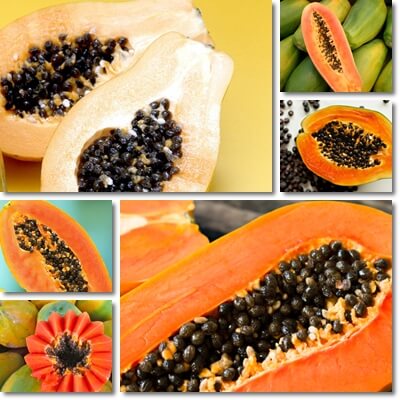The glycemic index, GI for short, is a scale that measures how fast the carbohydrates in a food raise blood sugar levels. Below 55 is a low GI. Between 56-69 is a moderate GI. Between 70-100 is a high GI. Diabetics and anyone looking to lower their blood sugar are advised to choose foods with as low a GI as often as possible and avoid high-glycemic foods to the best of their efforts. And one food they can eat is papaya. Although somewhat high in sugar and rather low in dietary fiber, it can be eaten with diabetes type 2 and type 1 so long as intake is kept moderate and according to the diabetic person’s individual nutritional requirements.
Papaya glycemic index: 59 (moderate)
The glycemic index of (ripe) papaya averages a score of 59 (moderate). What this means is that eating papaya with diabetes isn’t likely to affect blood sugar levels too much or generate a too high a rise, even though it’s not low-glycemic. Of course, intake is best kept reasonable so that the amount of carbohydrates you get from a serving of the fruit is not excessive. Because eating too much papaya at once offsets the benefits of its moderate glycemic index. It’s important to understand that 59 is an average GI score. What this means is that some fruits may have a GI lower than 59 or higher.

Variations in the glycemic index are to be expected because no two fruits are exactly the same. Factors such as degree of ripeness dictate the type and amount of carbohydrates in a fruit which, in turn, impact GI values. For example, unripe or less ripe fruit have more complex carbohydrates and dietary fiber which makes them harder to digest and potentially lowers their glycemic effects. The riper the fruit, the more complex carbohydrates in it become more readily digestible, basically turning into simple sugars (that’s also why fruits become sweeter as they ripen). This can generate higher GI scores for the fruit.
The glycemic index of ripe papaya
The glycemic index of ripe papaya ranges from 56 to about 60 or slightly higher, with an average score of 59. Canned papaya in natural juice borders on low-glycemic, with a GI score of 55 and lower. In some instances, papaya has even been found to be low-glycemic with a score as low as 34.80 (±12.78). Source: Glycemic Index values of some Jaffna fruits, published in Functional Foods in Health and Disease, 2012, 2(2):25-34.
The glycemic index of unripe, green papaya
Green papaya glycemic index is currently undetermined, but presumed low. How low-glycemic green papaya actually is depends on how unripe the fruit is and its carbohydrate content and profile at the stage of ripeness it’s tested. Laboratory tests would have to be performed on green papayas at various stages of their ripening process to obtain exact GI scores. But the unripe, green fruit is usually eaten cooked, not raw. And since cooking renders the complex carbohydrates in it more readily digestible, it’s possible for cooked, unripe green papaya to not actually be low-glycemic. The article will be updated with more information as soon as it becomes available.

How many carbs in a papaya?
Papaya is relatively low-carb with only 10.82 g of total carbohydrates per 100 g. One cup of 1-inch papaya pieces (145 g a cup) provides 15.69 g of carbohydrates. One cup of mashed papaya (230 g a cup) gets you 24.89 g of carbs. Even so, the fruit is best eaten in small amounts to avoid excesses that could make blood sugar go up, especially if you have diabetes type 2 or even type 1.
How much sugar in a papaya?
Papaya is not a low sugar fruit. 100 g provides 7.82 g of sugars, one cup of 1-inch pieces (at 145 g a cup) provides 11.34 g and 1 cup of mashed papaya (at 230 g a cup) provides 17.99 g. Its sugar content is somewhat comparable to that of sweet cherries (12.82 g per 100 g and 17.69 g per cup with pits -138 g a cup). But despite their significant sugar content, cherries are low-glycemic (20, 20-ish), whereas papayas are moderate-glycemic, albeit lower on the moderate GI scale. In any case, both are best eaten in moderation with diabetes. Also see Can You Eat Cherries With Diabetes?
Conclusion
Despite some variation having to do with the degree of ripeness of the fruit, the glycemic index of papaya is moderate, with an average GI of 59. Even so, the fruit is safe to eat with diabetes type 2 and type 1 and an ok choice because it doesn’t raise blood sugar levels excessively, when eaten in moderation of course. Ideally, keep to small amounts and maybe don’t have the fruit every single day or have multiple servings a day. If anything, this allows for some variation in your diet which favors optimal nutrition and good overall health.
Lastly, one of the most important aspects of papaya nutrition that may hold benefits specifically for diabetes is a generous vitamin C content (62 mg per 100 g of fruit). Vitamin C has scientifically proven anti-inflammatory and antibacterial properties as well as stimulates collagen production, helping with wound healing, an important aspect of diabetic health. Papaya is also a good source of lycopene and carotenoid antioxidants that favor skin and eye health as well as a varied source of B vitamins with benefits for nervous system health. Low in calories (43 kcal per 100 g), it does not encourage weight gain when consumed reasonably.
